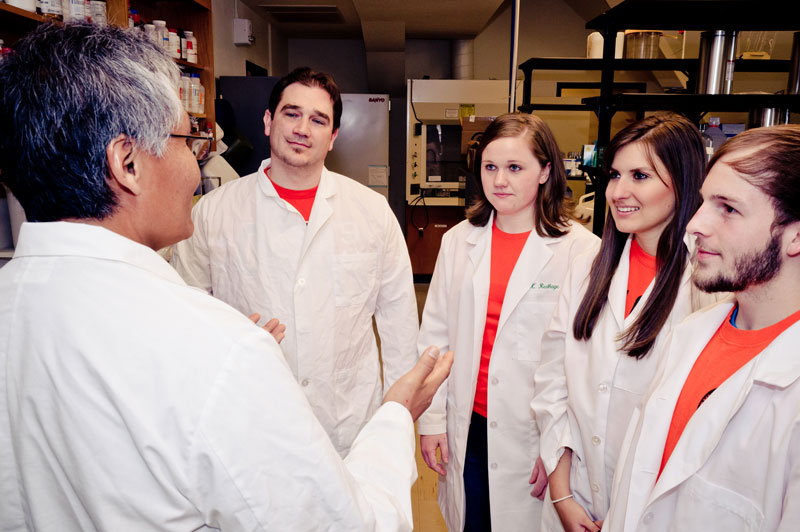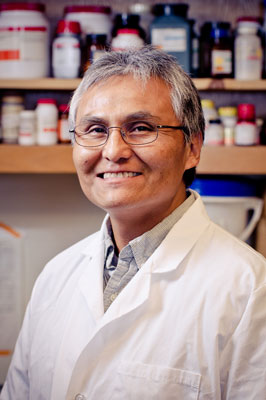The Scientific Process
Wednesday, July 15, 2015

Gilbert John’s love of science has taken him from his home on a Navajo Reservation
in Arizona to all over the United States. Along the journey, the Oklahoma State University
associate professor has worked hard to share his trek with other Native Americans.
“I didn’t fit the characteristic mold of the stereotypical scientist,” John, 50,
says of his circuitous route to become both professor and science mentor. “My interest
in science began with my love of animals.”
His original plan at Colorado State University was to be a veterinarian.
“As I got closer to graduation, a mentor, an immunologist, talked to me about science
and careers other than becoming a vet. He taught me about the whole world of scientific
research, teaching and service activities. It changed my career path.”
That career change has benefited current OSU students who spend summers assisting
in John’s research. He heads Science Scholars: The Native American Path, a program
that guides Native American students at OSU who are pursuing degrees in science, technology,
engineering and mathematical fields. It is funded by the Society for the Advancement
of Chicanos and Native
Americans in Science. Stillwater’s student chapter is one of 40 in the United States
and the only college chapter in Oklahoma.
“We want to give our minority students an opportunity to excel,” John says. “SSNAP
provides opportunities for our student to participate in training sessions focused
on academic success and professional development.”
In fall 2012, the society awarded OSU $40,000 and is committed to funding the program
for two more years. The society uses funds obtained from the National Institutes of
Health to support SSNAP.
This summer, John and two students — Lindsey Burger and Amber Anderson — worked on
his research project at the Brookhaven National Laboratory (BNL) on Long Island in
New York. Both students are incoming seniors. Burger is a zoology major and a member
of the Otoe Missouria tribe. Anderson, a Cherokee, is a biochemistry major.
“I study an enzyme found in bacteria that is found in the human intestine,” John
says.
“The enzyme breaks down different dyes found in consumer products, the color you
see in food, clothes and other things.”
The common colorants are called azo dyes. He explains that some azo dyes could become
toxic when broken down. A variety of azo dyes are used throughout the world. If they’re
accidentally consumed through food or water contamination, some of these dyes can
cause cancer.
“We’re interested in how the enzyme works,” John says. “I’ve been studying them for
the past 15 years. BNL, they’re experts. The structural biology department at BNL
can help determine the structure of the enzyme through a technique called crystallization.
When we know its structure, it allows us to do a lot to understand its function.”

This summer, John’s students learned the science that goes into the process.
“It gives them an indication of what scientific research is all about,” says John.
A question about whether his 15-year quest would scare most students away from a life
in the sciences makes him laugh. “It takes time and a special individual to dedicate
their life to cure a disease. And, it may take my lifetime. My 15 years is very small
compared to what some scientists have dedicated in their careers.”
The SSNAP funding also allows John to attend the SACNAS national conference. This
year’s conference is in San Antonio in October. More than 3,000 professional scientists
of predominately Hispanic/Chicano and Native American origin are expected to attend.
Because the conference is within driving distance of Stillwater, John says he plans
to take all 22 students in the OSU program to the conference.
“We hope to make a major impact,” John says.
By impact, John means participating in competitions that include peer-reviewed poster
presentations, where students are eligible for cash awards up to $500. However, the
conference offers more than cash awards.
“Our students meet with top-notch minority scientists who are dedicated to helping
them,” John says. “It is a low-key environment where Hispanic and Native American
students can feel comfortable.”
John hopes his mentoring and this program will draw more Native Americans into science
fields. He offers concrete suggestions for parents who want to encourage their children
toward science and math careers.
“First, encourage them to do well in school,” says John, thinking back to his own
parents. “Encourage them to go as far with their education as they can.”
He says it is important to spend time talking with kids about the importance of education.
“You also need to do things with your kids, not just tell them not to play video
games,” John continues.
“And, if you’re not that comfortable with math or science, find them a mentor who
can help them. That is the missing link,” he adds. “There are opportunities out there,
but students are lost without mentoring. We have to be able to share that information.”
John also has advice for those students who want to be considered for next summer’s
hands-on internship.
“You have to have the grades, a desire to learn, the ability to follow directions,”
says John, who also relies on advice from other faculty members. “Of course, my students
have an advantage because I know a lot about them: their characteristics and character,
interests, whether the program would benefit them.”
Interestingly, John’s own children aren’t in scientific fields. His oldest daughter,
26, is completing a master’s degree in political science, and his youngest, 22, is
earning a doctorate in education.
“I consider that a testament to my letting them become what they wanted to be,” he
says.
Story By Sylvia E. King-Cohen
